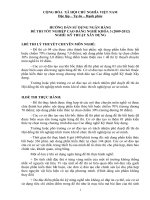Cẩm nang hướng dẫn PTE và đề thi mẫu
Bạn đang xem bản rút gọn của tài liệu. Xem và tải ngay bản đầy đủ của tài liệu tại đây (198.73 KB, 7 trang )
<span class='text_page_counter'>(1)</span><div class='page_container' data-page=1>
<b>Pearson Test of English Young Learners </b>
<b>Language Content</b>
Information within this document is from the Council of Europe Threshold specification.
© Council of Europe
No part of this publication may be reproduced without the prior permission of Pearson Education Ltd.
Firstwords (Level 1)
July 2018
</div>
<span class='text_page_counter'>(2)</span><div class='page_container' data-page=2>
<b>L</b>
<b>anguage Content </b>
The following list includes the types of language content that are typically assessed at this level
including areas of language use, main structures, topics and vocabulary. Structures and vocabulary
given in italics are for guidance only and are not intended to be a complete list.
<b>Areas of language use </b>
Introduce and greet other people
Identify people by name
Ask someone their name
Respond to simple instructions
Identify key classroom, household and other objects
Ask/answer about color and position of objects
Ask/tell someone their/your age
Ask/talk about families
Request things
Express simple likes
Suggest simple activities
</div>
<span class='text_page_counter'>(3)</span><div class='page_container' data-page=3>
<b>Main structures </b>
•
Has / Have got
<i>I’ve got a dog. Has he got a dog? He hasn’t got a cat.</i>
•
There is / are
<i>How many dogs are there?</i>
•
The imperative and negative imperative
<i>Get up. Sit down. Be quiet. Don’t touch.</i>
•
The verb ‘to be’ in the present tense
<i>He’s John. Are you Mary? I’m not tired.</i>
•
The present continuous (affirmative only)
<i>Mr Brown is watching television.</i>
•
‘Can’ for ability and requests
<i>Mrs Brown can swim.</i>
•
‘Let’s’ for simple suggestions
<i>Let’s go to the cinema.</i>
•
Basic question words
<i>What? Where? What color? Who? How many? How much? Which?</i>
•
Demonstratives - pronouns and adjectives
<i>This is… That’s… Is this/that…? This book is good.</i>
•
Possessive ‘s’
<i>Ben’s book</i>
•
Personal and possessive pronouns and adjectives
<i>I, mine, my etc</i>
•
Plural of nouns
<i>books, cats, classes, houses, children, men, women</i>
•
Prepositions of place
<i>The book is on/under/by the chair.</i>
22
•
Simple conjunctions
</div>
<span class='text_page_counter'>(4)</span><div class='page_container' data-page=4>
<b>Topics </b>
•
Families
•
Pets and Animals
•
School
•
The Body and People’s Appearance
•
Toys
•
Houses
<b>Vocabulary </b>
•
Simple colors
<i>red, blue, green, yellow</i>
•
Nouns for family members
<i>mother, father, mum, dad, brother, sister, aunt, uncle, grandmother</i>
•
Numbers from 1 to 20
•
The house
<i>kitchen, bathroom, bedroom, garden</i>
•
Parts of the body
<i>arm, leg, head, back</i>
•
Children’s clothes
<i>T-shirt, shorts, sweatshirt, baseball cap, trainers</i>
•
Basic adjectives for feelings
<i>happy, sad, tired, hungry</i>
•
Common pets and zoo animals
<i>dog, cat, tortoise, rabbit, snake, monkey, lion, tiger</i>
•
Common toys/playthings
<i>bicycle, computer games, doll</i>
•
Verbs often used for classroom instruction
<i>sit down, stand up, open your books, write, fill in</i>
•
Classroom objects
</div>
<span class='text_page_counter'>(5)</span><div class='page_container' data-page=5>
<b>Vocabulary List </b>
The following tables include the vocabulary typically tested at Firstwords (Level 1).
<b>A </b>
<b>B </b>
<b>C </b>
<b>D </b>
<b>E </b>
<b>F </b>
<b>G </b>
<b>H </b>
</div>
<span class='text_page_counter'>(6)</span><div class='page_container' data-page=6></div>
<span class='text_page_counter'>(7)</span><div class='page_container' data-page=7>
<b>Q </b>
<b>R </b>
<b>S </b>
<b>T </b>
<b>U </b>
<b>V </b>
<b>W </b>
<b>Y </b>
</div>
<!--links-->









